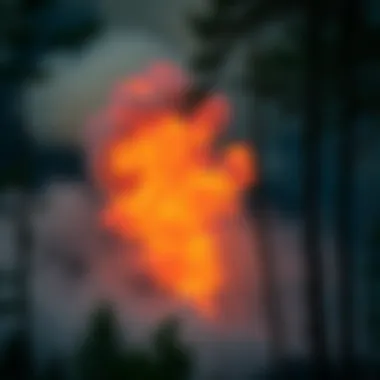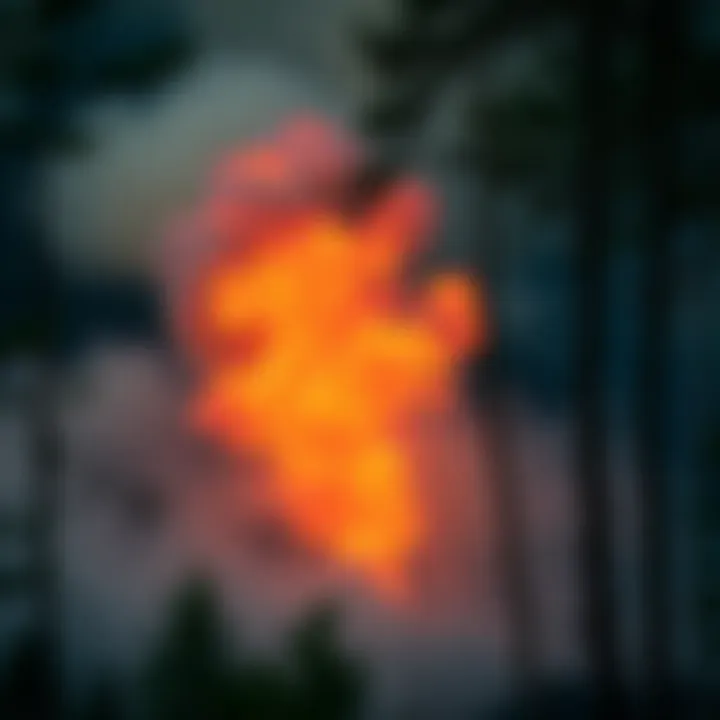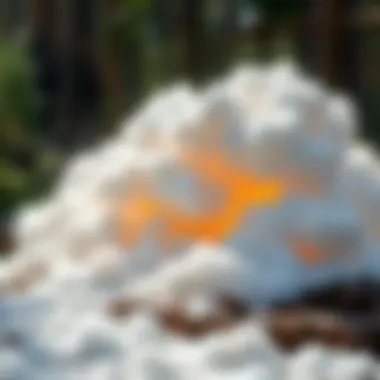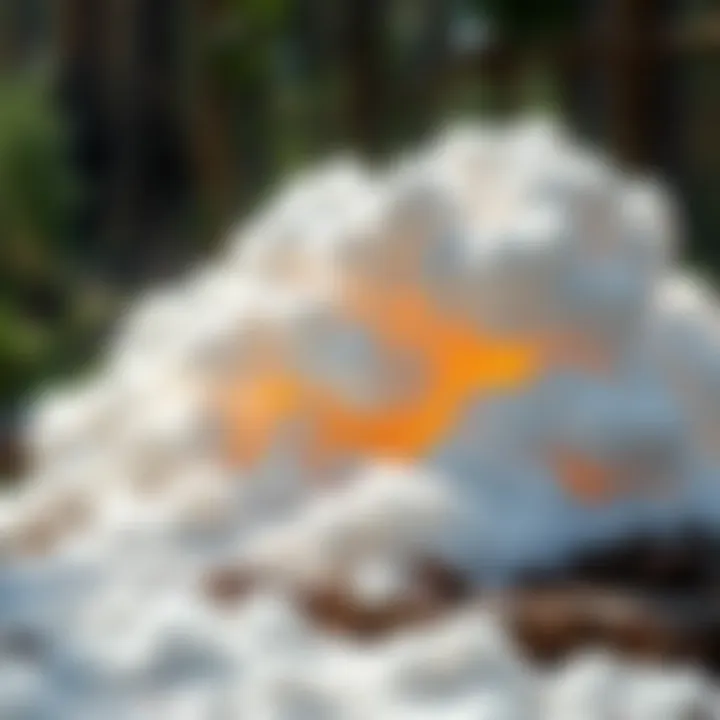Foam's Impact on Wildfire Control and Management


Intro
As the climate continues to shift, wildfires have become an increasingly pressing issue in many regions around the world. The destructive power of these blazes not only poses a threat to biodiversity but also jeopardizes human life and property. In the face of such challenges, innovative approaches to fire suppression are essential. One of the most effective tools in the firefighting arsenal is foam technology. By examining the intricacies of foam in fire suppression, we delve into its unique attributes, tactical benefits, and the careful consideration necessary to balance efficiency with environmental stewardship.
Understanding the role of foam can significantly benefit forestry professionals, enabling more effective fire management strategies. This article covers a variety of topics, from the scientific background of foam suppression, recent advancements in its formulations, to practical applications employed in forest fire management. Through this exploration, we aim to provide a comprehensive perspective on how foam acts as a catalyst for sustainable fire control practices.
Prolusion to Wildfire Dynamics
Understanding the dynamics of wildfires is crucial when exploring effective suppression techniques, such as foam use. Wildfires are not mere accidents; they are complex phenomena driven by interactions between the environment, fuel sources, and weather conditions. By grasping these dynamics, forestry professionals can better anticipate fire behavior, leading to more strategic firefighting practices that save both property and lives.
Understanding Wildfires
A wildfire occurs when an uncontrolled fire spreads through vegetation, fueled by dry leaves, trees, and grasses. The causes of these fires can range from natural occurrences like lightning strikes to human actions such as discarded cigarettes or campfires left unattended. Understanding the behavior of wildfires—how they ignite, spread, and are extinguished—forms the bedrock of effective fire management.
Wildfires can be categorized into different types, notably surface fires, which burn along the forest floor, and crown fires, which leap from treetop to treetop. Each type presents unique challenges. For instance, crown fires often move faster and are significantly harder to contain, heightening the need for effective suppression strategies like foam application.
From the arid landscapes of California to the dense pine forests of the Pacific Northwest, the environments where wildfires flourish vary widely. Each ecosystem has distinct characteristics that influence fire dynamics. This variation necessitates a tailored approach, wherein understanding local fire behavior becomes imperative.
Factors Influencing Fire Behavior
Fire behavior in wildfires is influenced by a trifecta of factors: fuel, weather, and topography. By breaking these down, one can better appreciate how they interact to create fire conditions.
- Fuel: The amount and type of vegetation present can dramatically alter a fire's intensity. For instance, grasslands burn quickly, while thickly forested areas might allow fires to smolder for prolonged periods.
- Weather: Wind speed and humidity levels are significant players in fire dynamics. High winds can fan flames, rapidly increasing the spread of a wildfire, while an increase in humidity can suppress fire activity by saturating fuels.
- Topography: The lay of the land can also impact fire behavior. Fires tend to move uphill faster than downhill, as heat rises, and steeper slopes can create a chimney effect, accelerating fire movement.
To effectively combat wildfires, one must not only work to suppress flames but also understand how these factors interplay. This understanding ultimately helps in planning defensive strategies that can protect both lives and landscapes.
Given that wildfires are becoming more frequent and severe, having a well-rounded grasp of wildfire dynamics is more important than ever. As we dive deeper into foam suppression technology, recognizing how these fire elements interact will pave the way for innovative and effective fire management techniques.
Foam Fire Suppression: An Overview
Foam fire suppression has emerged as a crucial tool in the battle against wildfires, providing distinct advantages over traditional methods. As wildfires become more frequent and severe, understanding the role of foam in fire control gains significance. This section will elaborate on why foam suppression matters, exploring its unique benefits as well as the essential details surrounding its use.
Foam acts by creating a barrier, inhibiting the fire's access to oxygen while cooling the flames. In situations where water alone may prove ineffective or even detrimental—such as in volatile forest compositions—foam provides a potent alternative. Its effectiveness lies in its composition; foams can penetrate and adhere to surfaces, covering burning materials more thoroughly than water. For instance, imagine a wildfire advancing through a dense stand of pine trees. Conventional water application may struggle against the high heat and rapid fire spread. However, foam can blanket those trees, substantially reducing the risk of ignition and allowing for a window of time to implement further firefighting strategies.
The consideration of foam use extends beyond mere effectiveness; there are real advantages that appeal to fire management teams. Below are some key points regarding foam's role in firefighting:
- Versatility: Foam can be used in various scenarios, including structural fires, wildfires, and even in urban settings, making it a versatile resource for firefighters.
- Increased Efficiency: The ability to suppress fires quicker means foam can minimize damage and better protect life and property.
- Cost-Effectiveness: When factoring in water savings and the potential to prevent large-scale fire damage, foam systems can offer economic benefits to firefighting services.
While foam is a remarkable innovation for fire suppression, it’s also imperative to hedge against potential pitfalls. Using foam responsibly includes understanding the environmental impacts and ensuring that firefighting practices align with sustainable objectives. Ultimately, as firefighting technology advances and wildfires increase in intensity, foam will likely continue to play an integral role in contemporary fire management.
The Mechanism of Foam in Fire Control
Fires require three components to ignite and sustain: heat, fuel, and oxygen—also known as the fire triangle. Foam introduces a fourth element: the physical barrier. Foam blankets a fire, covering the fuel and cutting off its oxygen supply. The cooling effect of the foam reduces the heat, while the built-in surfactants in foam allow it to coat surfaces evenly, ensuring extensive coverage.
Moreover, the bubble structure of foam traps air and water within its form. As these bubbles collapse, they release moisture and create a mist effect, which can further inhibit fire propagation. This multi-faceted approach makes foam suppression particularly effective in managing larger fires, where water alone may evaporate before making an impact.
Types of Foam Used in Firefighting
Not every foam product is created equal; various types have been developed to tackle specific challenges in fire suppression. Some of the commonly utilized foams include:
- Aqueous Film Forming Foam (AFFF): This type spreads quickly and efficiently over flammable liquids, making it suitable for aviation and industrial fires. It creates a film that interrupts the fire’s contact with oxygen.
- Class A Foam: Designed for ordinary combustibles like wood and paper, this foam enhances water's effectiveness by allowing it to cling to surfaces better and penetrate materials.
- Alcohol-Resistant Foam: This form is formulated to resist the solubility of alcohol-based fuels, making it particularly valuable in industrial settings where such fuels are prevalent.
Advantages of Foam Fire Suppression
The utilization of foam in firefighting, particularly for wildfires, has brought a paradigm shift in how we manage and combat these devastating blazes. Foam offers several advantages that traditional water-based methods simply cannot match. It is not just about extinguishing flames; it’s about optimizing firefighting efforts and resources effectively. We will delve into three significant benefits of foam applications in fire suppression: efficacy compared to water, reduced water consumption, and enhanced coverage and penetration.
Efficacy Compared to Water


When it comes to fire suppression, the effectiveness of foam is a remarkable aspect that stands out. Foam works by smothering flames and cooling the ambient temperature, creating a blanket that prevents oxygen from fueling the fire. This differs from water, which primarily relies on soaking and cooling to suppress flames. While water is beneficial, foam's ability to encapsulate and isolate the fire area often leads to faster extinguishing times and more efficient operations.
Firefighters have found that foam is significantly effective against various fuels beyond what water can tackle. For instance, in cases of flammable liquids or class B fires, foam's unique composition of bubbles can form a barrier, preventing vapors from rising and igniting further. This nuanced approach is vital for preventing fire reignition.
"Foam’s power lies not just in its extinguishing ability, but in the control it asserts over fire dynamics."
Reduced Water Consumption
Water scarcity is an undeniable reality in many wildfire scenarios, especially in drought-prone areas. The sheer volume required to combat raging fires can be staggering and often unsustainable. Foam, on the other hand, requires significantly less water to be effective. By utilizing foam-based solutions, firefighters can cut down on water usage by as much as 90% while still achieving effective suppression.
This not only conserves precious water resources but also reduces the burden on local water supplies. In regions where wildfires are raging, every drop counts. Moreover, the reduction in water consumption translates to fewer resources needed for transportation and logistics, allowing for a more rapid response in urgency.
Enhanced Coverage and Penetration
Foam excels in its capacity to cover an area thoroughly and penetrate fuels more effectively than water. The structure of foam allows it to cling to surfaces, forming a protective layer that shields against heat and flames. This is especially useful in densely wooded areas or brushlands where traditional methods may struggle to reach hot spots hidden among foliage.
In particular, the ability of foam to envelop the fuel source ensures that the fire does not sneakily reignite in places that may remain damp when only water is applied. The foam can even penetrate through layers of vegetation, ensuring that a comprehensive treatment occurs rather than surface-level watering. This characteristic not only helps in putting fires out but also aids in preventing their spread in the future.
In summary, foam fire suppression showcases distinct advantages, from its superior extinguishing capabilities and water conservation to its quite remarkable coverage and penetration strengths. These factors combine to make foam an invaluable tool in the firefighting arsenal, addressing not only immediate fire suppression needs but also promoting sustainable practices for environmental stewardship.
Environmental Considerations
In the current climate scenario, the environmental implications of firefighting methods are more critical than ever. With wildfires becoming increasingly prevalent due to climate change, it is imperative to analyze the environmental considerations of foam usage in fire suppression. It’s not just about putting out fires; understanding how foam interacts with ecosystems is crucial for ensuring sustainable practices in firefighting.
Impact of Foam on Ecosystems
Foam can serve as a double-edged sword in fire suppression. While it effectively smothers flames by forming a barrier and preventing oxygen from reaching the fuel source, it can also have adverse effects on the surrounding environment. The ingredients in some foam formulations may contain harmful chemicals that can seep into the soil and water systems, impacting flora and fauna. For instance, certain types of fluorinated foams have been linked to toxicological effects in aquatic life. This creates a significant concern for areas where biodiversity needs protection.
On the flip side, some newer foam formulations are designed specifically to minimize environmental impact. These are less likely to have long-lasting effects, but a detailed understanding of their composition is necessary. Studies have suggested, for example, that using a foam that breaks down rapidly in the environment can significantly lessen harm compared to conventional options. As such, making informed choices about foam usage is crucial for maintaining healthy ecosystems alongside effective fire suppression.
"Firefighting foam can be either a savior or a hazard, depending on its composition and deployment in sensitive environments."
Biodegradable Alternatives
As the discourse surrounding foam's environmental impact gains traction, the push for biodegradable alternatives is gaining momentum. The goal is to develop firefighting solutions that not only extinguish fires but do so in a way that is harmonious with nature. Options like plant-based foam are being explored, containing organic materials that break down more quickly than traditional foams.
These alternatives often lack toxic chemicals, thus posing a lesser threat to both wildlife and plant species. Countries like New Zealand and Australia are leading the charge in researching such biodegradable foams, looking into options that integrate natural surfactants and non-toxic propellants. The research indicates that while these alternatives may sometimes require refinement for effectiveness, the long-term ecological benefits can outweigh initial hesitations regarding performance.
In sum, it appears that the future of foam usage in wildfires may lean toward environmentally friendly options that align firefighting needs with ecological stewardship. It’s essential that ongoing research continues to prioritize sustainable solutions while fire suppression efforts evolve.
Operational Tactics in Foam Application
The effectiveness of foam in combating wildfires hinges not just on its chemical properties but also on how it is applied. Operational tactics directly influence the success of foam application strategies. The right tactics can be the difference between controlling a blaze and allowing it to spread uncontrollably. Understanding the nuances involved in deploying foam effectively is essential for firefighters and forestry professionals alike.
Strategies for Effective Deployment
Effective deployment of foam requires a well-thought-out strategy. First things first, determining the fire behavior and surrounding terrain is crucial. This initial assessment helps firefighters understand how the fire might spread. Once they gauge the situation, they can deploy foam in targeted areas.
- Pre-Planning: Having a pre-determined plan on how and where to deploy foam can make a significant impact. This includes identifying hot spots and vulnerable locations ahead of time.
- Wind Direction Consideration: Wind can be a game-changer when it comes to fire dynamics. Deploying foam in the wind direction, rather than against it, maximizes effectiveness by reducing foam drift.
- Layering Techniques: One effective method includes creating a foam layer beneath the flames, which can smother and cool the fire. This tactic involves a combination of both aerial and ground applications to cover the area thoroughly and rapidly.
- Area Containment: Effective containment of the fire perimeter often utilizes foam walls, which provide a barrier, preventing the fire from spreading further. This method is particularly beneficial in rugged terrain where water sources might be limited.
Deployment techniques vary but often incorporate mobile units that can traverse difficult landscapes or aerial units for quick coverage over vast areas. Regardless of the approach, flexibility is key to dealing with dynamic fire situations.
Coordination with Ground Crews and Aerial Support
For foam application to be effective, coordination between ground crews and aerial support cannot be overstated. The two must work in tandem to optimize resource use and ensure comprehensive coverage of the affected area.
- Real-Time Communication: Establishing clear lines of communication between aerial units and ground crews is paramount. This involves sharing vital information about wind speed, fire movement, and foam deployment areas. Ground crews can inform aerial support of specific hotspots that require immediate attention.
- Adjusting Tactics on the Fly: The teams should be prepared to recalibrate tactics quickly based on changing fire conditions. For instance, if a sudden flare-up occurs in a previously assessed area, aerial support can adjust its deployment patterns in real-time, responding to the shift effectively.
- Integrated Training: Regular joint training exercises can help streamline cooperation between teams. Understanding each crew's capabilities and limitations builds a cohesive unit that can operate seamlessly when faced with real-life challenges.


"Effective firefighting is not just about putting out a fire; it's about strategizing, adapting, and collaborating for a successful outcome."
By focusing on these operational tactics and fostering strong coordination, firefighters can significantly improve the chances of controlling wildfires and minimizing their destructive potential. The integration of foam technology into these strategies enhances the efficiency of fire management efforts, reflecting an essential evolution in wildfire response methodologies.
Innovations in Foam Technology
Foam technology has significantly evolved over the years to address the growing challenges posed by wildfires. As wildfires become more frequent and intense due to climate change, the need for effective fire suppression tools has never been more critical. Innovations in foam technology can enhance firefighting efforts, offering enhanced capabilities that traditional methods often lack.
A key aspect of these innovations is the advancements in foam formulation. Modern foams are being engineered for greater efficiency, effectiveness, and environmentally friendly attributes. Unlike older versions that may leave harmful residues post-application, newer formulations are focused on minimizing their ecological footprint while maximizing their firefighting potential. These advancements often include the integration of hydrocarbon-based surfactants, enabling foams to form a thicker blanket that suffocates flames and prevents reignition.
Moreover, specific benefits of these advancements in foam formulation include:
- Increased Stability: Modern foam formulations are designed to remain stable over longer periods, which is crucial when responding to slow-moving or smoldering wildfires. This stability often translates to better control during firefighting operations.
- Greater Penetration: Enhanced foams can penetrate fuel sources more effectively. This means they can reach the heart of a fire, not just the surface, aiding in quicker suppression.
- Improved Safety: As formulations advance, they also often prioritize firefighter safety by reducing the inhalation risks associated with older foam types. This aspect cannot be overstated in the chaotic environment of wildfire management.
"Innovative foam formulations are reshaping the landscape of firefighting, bridging the gap between traditional methods and the urgent demands of today’s fire suppression needs."
Following advancements in foam formulation is the integration with remote sensing and AI. This modern approach utilizes technology to optimize foam deployment strategies in real-time, allowing firefighters to assess situations better and respond more efficiently. For instance, remote sensing can provide data on fire behavior and vegetation patterns, enabling command teams to deploy foam in the most strategic locations.
Incorporating artificial intelligence in this context further aids in decision-making processes, predicting how a fire might spread based on existing conditions and allowing for proactive rather than reactive firefighting. This is particularly vital when dealing with complex wildfire scenarios where human monitoring can fall short due to the scale or unpredictability of the fire activity.
As we look towards the future, understanding and investing in these innovations will be paramount for any firefighting strategy focused on sustainability and efficacy.
Case Studies and Field Applications
The realm of foam fire suppression is not just theoretical; it is grounded in real-world applications that showcase its effectiveness. By analyzing specific case studies, we can glean valuable insights into both the potential and the limitations of foam deployment in firefighting. This helps to solidify the understanding of how foam can be a cornerstone in wildland fire suppression strategy.
Successful Foam Deployments in Major Fires
Examining successful foam deployments allows us to recognize the tangible benefits that foam technology brings to wildfire management. For instance, during the historic California wildfires in 2020, foam was deployed in strategic locations. In areas with dense vegetation, foam created a barrier that effectively suffocated flames while also preventing the fire's spread to surrounding communities. Different foam formulas were used, including AFFF (Aqueous Film Forming Foam), which not only suppressed flames but also created a protective film over fuels. This combined effect delayed re-ignition significantly, leading to greater containment of the fires.
Another notable example occurred during the 2019 Amazon rainforest fires, where specialized foam was aerially delivered. Traditional water drops had minimal effects given the size and intensity of the blazes. The foam proved beneficial, allowing for rapid coverage over vast areas. This extended reach of effectiveness provided critical moments for on-ground crews to regroup and strategize further attack plans.
Such accounts highlight that foam is not merely an accessory in the fight against wildfires; it often becomes essential in turning the tide against advancing flames.
Lessons Learned from Operational Experiences
Each deployment of foam in firefighting provides a wealth of knowledge, revealing both successes and challenges faced in the field. One of the key takeaways from studies involving foam usage is the importance of proper training for personnel in its application. Miscalculations in foam-to-water ratios can lead to ineffective suppression, drawing attention to the need for certified training programs focusing on foam technology.
Moreover, there were instances where environmental considerations became critical. For example, in scenarios where foam was deployed on sensitive ecosystems, the aftermath was not without consequences. In a long-term examination conducted in Southern Australia post-deployment, some formulations of foam were found to impact local water bodies. This brought about discussions on using biodegradable alternatives and more sustainable practices without sacrificing effectiveness. Clear and careful assessments prior to deployment have become standard learning points for teams moving forward.
Equally, operational data has emphasized collaboration among teams. Communication breakdowns during operations led to ineffective foam deployment at critical moments. Therefore, establishing clear lines of communication and planning ahead is as crucial as the equipment used.
In evaluating these lessons, it's evident that the combination of strategic application, ongoing training, and environmental stewardship forms a well-rounded approach to combatting wildfires with foam. The ongoing evolution within fire management policies emphasizes these areas, underscoring the potential of foam while managing its environmental footprint.
"The challenges faced and lessons learned in the field serve as the stepping stones towards more efficient firefighting strategies, paving the way for a resilient approach to wildfires as a whole."
Policy and Regulation Surrounding Foam Usage
The intersection of firefighting foam technology and systemic policy frameworks cannot be overstated. In a world increasingly susceptible to wildfires, understanding the regulations surrounding foam usage is crucial, not only for effective fire suppression but also for environmental safety and accountability. As fire-related incidents increase, so do the demands for ethical and informed use of foam in firefighting operations.
The regulatory landscape governs how fire extinguishers and firefighting foam can be employed. These regulations aim to ensure public safety and ecological preservation while facilitating effective response strategies. For professionals in the field, being well-versed in these frameworks is vital for compliance and optimal operational execution. Moreover, policymakers must stay attuned to technological progressions within foam formulation; this can aid in steering legislative approaches that safeguard both human lives and the environment.
Current Regulatory Frameworks
Currently, various governing bodies manage the regulations associated with firefighting foams. The Environmental Protection Agency (EPA) in the United States, for example, regulates the use of certain surfactants and chemicals found in firefighting foams. Specific focus is placed on PFAS (per- and polyfluoroalkyl substances), which are often found in traditional foam formulas. These substances have come under scrutiny for potential environmental contamination and health risks. As a result, states have initiated their own legislation to either ban or restrict the use of certain foams, contributing to the complexities in compliance for firefighting methods.
Just as regulations vary from state to state, they also differ from region to region globally. Some countries have stringent rules surrounding foam usage, focusing on curtailing harmful substances, while others lack proper frameworks altogether. This inconsistency poses challenges for international firefighting teams that may operate across borders.


- Key Elements of Current Regulatory Frameworks:
- Safety Practices: Making sure foam doesn’t pose health risks to firefighters or the community.
- Environmental Assessments: Evaluating foam products before approvals to prevent future contamination.
- Accountability Measures: Enforcing penalties for non-compliance, ensuring that organizations stay responsible.
Future Directions for Governance
Looking ahead, the evolution of foam regulations hinges on several crucial factors. Emphasis must be placed on developing biodegradable foams that meet the requirements of effective fire suppression without detrimental ecological impact. As research enhances our understanding of eco-friendly products, regulatory policies must adapt to reflect these new solutions.
Moreover, collaborations between government agencies, environmentalists, and firefighting experts can foster a multidimensional approach to policy formulation. This collaborative framework can lead to the establishment of comprehensive guidelines that not only govern the usage of foam but also guide training and education for firefighting personnel.
As the impacts of climate change intensify wildfire occurrences, authorities will likely need to reassess their existing frameworks. Potential adaptations may include faster legislative processes for approving innovative foam technologies and aligning policies with international standards for fire management.
In summary, it’s clear that effective regulation surrounding foam usage goes beyond just compliance. It forms the backbone of safe and sustainable firefighting practices. As we move forward, understanding how these policies are crafted and evolved will be crucial for professionals in the field, enabling them to protect lives and the environment effectively.
“Regulatory frameworks are not just barriers; they are bridges toward a safer and more conscious firefighting approach.”
For further information about current regulations, consider visiting the Environmental Protection Agency or relevant forestry research institutions like USDA Forest Service.
Training and Professional Development in Foam Usage
The role of effective training and professional development is crucial in enhancing the skills of firefighters when it comes to foam usage in firefighting. Wildfires can escalate quickly, and understanding the nuances of foam technologies can make the difference between a successful fire suppression effort and a catastrophic failure. This section delves into vital elements that define the path for ongoing education for fire professionals, focusing on the benefits and considerations of robust training programs.
Training in foam application equips firefighters with essential tactical knowledge, allowing them to assess various scenarios. This knowledge includes recognizing different types of foam, understanding the chemical properties that give it its fire-suppressing capabilities, and being skilled in the correct deployment techniques. Proper training leads to better decision-making on-the-spot, ultimately contributing to firefighter safety and operational efficiency.
Essential Skills for Firefighters
Mastering foam application requires a blend of analytical and practical skills. Several key competencies are paramount for effective foam usage:
- Comprehension of Foam Types: Firefighters must understand the distinctions between various foams—like Aqueous Film-Forming Foam (AFFF) or Class A foams—recognizing when to deploy each type based on the nature of the fire.
- Application Techniques: Training should encompass both manual and mechanical application methods, ensuring that personnel can skillfully use foam during different firefighting situations.
- Safety Protocols: Awareness of health and environmental implications stemming from the use of foam substances is fundamental to ensuring safety for both firefighters and the surrounding ecosystems.
- Situational Awareness: Understanding fire behavior and environmental conditions can inform more effective foam application. This includes knowing when to retreat if a situation turns perilous.
With these competencies, firefighters find themselves not only prepared to combat fires but also proactive in formulating strategies that leverage foam effectively against emerging wildfire threats.
Certification Programs and Resources
Certification programs tailored to foam usage are integral for sustaining a high standard of firefighting. These programs often provide structured training pathways, enabling firefighters to gain accredited qualifications that validate their expertise in foam application. Resources for certification may include:
- National Fire Academy: They offer courses that cover various aspects related to foam usage.
- International Fire Service Training Association: This institution regularly updates their training materials to incorporate the latest in foam technology and tactics.
- Community Colleges and Vocational Schools: Many local institutions provide specialized training that focuses on firefighting with foam, introducing practical sessions along with theory.
By leveraging these educational opportunities, firefighters can not only enhance their own skills but also foster a culture of continuous professional development. Keeping current with advancements in foam technology and firefighting strategies ensures that readiness stays high amidst changing wildfire dynamics.
"Training isn’t just a checkbox; it’s an investment in the future of our safety and effectiveness on the frontline."
In sum, prioritizing training and professional development around foam usage is essential. It equips firefighters with the skills, knowledge, and confidence required to tackle wildfires effectively, ensuring that when the call comes, they are ready to fight fire with fire—using foam.
Culmination and Recommendations
As we draw to a close on the examination of foam's role in fire suppression, it's imperative to stress that this technology stands as a pillar in modern firefighting. The use of foam not only enhances the efficiency of fire suppression efforts but also supports the overarching goal of minimizing both ecological and economic damages. The significant advantages of foam over traditional water methods, paired with its ability to create lasting barriers against flame resurgence, make it invaluable in today’s firefighting landscape.
Summarizing the Role of Foam in Fire Management
Foam serves as a multifaceted approach in fire management. Not merely a replacement for water, foam modifies the very dynamics of firefighting. The technology works through smothering, cooling, and separating fuel sources from oxygen. Manufacturers have tailored various foam formulations specifically for diverse types of fires, which shows adaptability to different environments and situations. This aspect is key – as wildfires can range in behavior dramatically due to factors such as vegetation type, weather conditions, and terrain.
Foam, notably, can be deployed swiftly from both ground-based units and aerial support. This flexibility allows for a coordinated attack on fires, critical in fast-moving situations. Ultimately, this effective suppression not only aims to protect human life but also aims for the preservation of natural ecosystems impacted by wildfires.
"Foam fire suppression is not simply a tactic; it's an evolution in our approach to dealing with wildfires."
Future Research Directions
Looking ahead, it’s vital to explore innovative pathways that can push foam technology further into effectiveness and sustainability. Research may focus on several avenues:
- Biodegradable Foam Formulations: There is a pressing need to develop foam products that are environmentally friendly. Moving away from perfluorinated compounds could reduce long-term ecological impacts.
- Integration with Emerging Technologies: Utilizing drones and AI for real-time monitoring and deployment of foam in fire-prone areas stands to revolutionize aerial firefighting strategies. This could enhance the precision of foam application and anticipation of fire behavior.
- Long-Term Ecological Studies: Further research into the effects of foam on various ecosystems over extended periods will provide insight on how to balance effective fire suppression with ecological integrity. Understanding flora and fauna response to foam usage could lead to more informed practices.
- Training and Preparedness Programs: Updating professional training programs through continuous learning about foam’s applications amidst the current landscape of wildfire risks will foster efficiency among firefighters themselves.
By focusing on these areas, future studies can greatly contribute to refining fire management strategies and ensuring that foam remains a sustainable and effective tool for combating wildfires.















